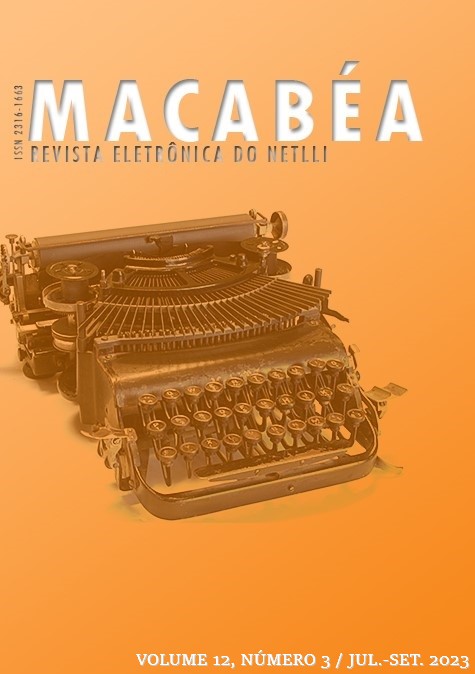MELANCHOLY, FEAR, AND DEATH:
THE GOTHIC IN PROSAS BÁRBARAS, BY EÇA DE QUEIRÓS
DOI:
https://doi.org/10.47295/mren.v12i3.1081Keywords:
Prosas Bárbaras, Gothic Topoi, Fear, Portuguese LiteratureAbstract
The current study is an analysis of the short stories presented in Prosas Bárbaras (1903), by Eça de Queirós. To do so, it is adopted the perspective that those narratives dialogue with gothic topoi. In other words, discourses, images, and narratives resources repeated through different works, creating commonplaces. In this sense, it is studied how those short stories dialogue with the pre-existing topoi in the Gothic tradition. It is searched for the comprehension of the negative effects that those resources may cause in the reader. This research also retakes the editorial path of those stories, showing that the narratives are mostly part of Eça de Queirós’ initial career. So, to understand the gothic theories researchers such as David Stevens (2000), G. Byron e D. Punter (2004), Nick Groom (2012), Fred Botting (2014), and Júlio França (2017) are mentioned.
References
BALDICK, C. Oxford Dictionary of Literary Terms. New York: The Oxford University Press, 2008.
BARTHES, R.; BOUTTES, J-L. Lugar-comum. In: ROMANO, R (Dir). Enciclopédia Einaudi. Porto: Casa da Moeda, 1987, p. 267-77.
BOTTING, F. Gothic. 2. ed. New York: Routledge, 2014.
BURKE, E. A Philosophical Inquiry Into The Origin Of Our Ideas Of The Sublime And Beautiful; With An Introductory Discourse Concerning Taste. In: BURKE, E. The Works of the Right Honourable Edmund Burke. London: John C. Nimmo, 1887, n.p. Disponível em: <https://www.gutenberg.org/files/15043/15043-h/15043-h.htm#A_PHILOSOPHICAL_INQUIRY>. Acesso em: 30 de ago. de 2023.
CAL, E. G. da. Língua e estilo em Eça de Queirós. Rio de Janeiro: Editora da Universidade de São Paulo/Tempo Brasileiro, 1969.
CURTIUS, E. R. Literatura europeia e idade média latina. São Paulo: Editora Universidade de São Paulo: 2013.
DEILILLE, M. M. G. A recepção literária de H. Heine no romantismo português. Lisboa: Imprensa Nacional/Casa da Moeda, 1984.
FRANÇA, J. Introdução. In: FRANÇA, J. (Org.). Poéticas do mal: A literatura do medo no Brasil. Rio de Janeiro: Bonecker, 2017, p. 19-35.
GROOM, N. The Gothic: A Very Short Introduction. Hampshire: Oxford University Press, 2012.
JACKSON, R. Fantasy: literature of subversion. London and New York: Methuen, 1981.
KAWABATA, M. Paganini: the “Demoniac” virtuoso. Woodbridge: Boydell Press, 2013.
QUEIRÓS, E. de. Prosas bárbaras. São Paulo: Editora Brasiliense, 1961.
QUEIRÓS, E. de. Contos I. Lisboa: Imprensa Nacional - Casa da Moeda: 2004
PIWNIK, M-H. Introdução. In: QUEIRÓS, E. de. Contos I. Lisboa: Imprensa Nacional - Casa da Moeda: 2004, p, 15-32.
PUNTER, D.; BYRON, G. The gothic. [S.l.]: Blackwell Publishing, 2004.
REIS, J. B. Introdução. In: QUEIRÓS, E. de. Prosas Bárbaras. Porto: Livraria Chardon, 1903, p. X-LIII. Disponível em: < https://archive.org/details/prosasbarbarasco00quei/mode/2up >. Acesso em: 30 de ago. de 2023.
STEVENS, D. The Gothic Tradition. Cambridge: Cambridge University Press, 2000.
TODOROV, T. Introdução à literatura fantástica. São Paulo: Perspectiva, 2017.
Downloads
Published
How to Cite
Issue
Section
License
Copyright (c) 2023 Xênia Amaral Matos

This work is licensed under a Creative Commons Attribution-NonCommercial-ShareAlike 4.0 International License.
Autores que publicam nesta revista concordam com os seguintes termos:
a. Autores mantém os direitos autorais e concedem à revista o direito de primeira publicação, com o trabalho simultaneamente licenciado sob a Licença Creative Commons Attribution que permite o compartilhamento do trabalho com reconhecimento da autoria e publicação inicial nesta revista.
b. Autores têm autorização para assumir contratos adicionais separadamente, para distribuição não-exclusiva da versão do trabalho publicada nesta revista (ex.: publicar em repositório institucional ou como capítulo de livro), com reconhecimento de autoria e publicação inicial nesta revista.
c. Autores têm permissão e são estimulados a publicar e distribuir seu trabalho online (ex.: em repositórios institucionais ou na sua página pessoal) a qualquer ponto antes ou durante o processo editorial, já que isso pode gerar alterações produtivas, bem como aumentar o impacto e a citação do trabalho publicado (Veja O Efeito do Acesso Livre).










